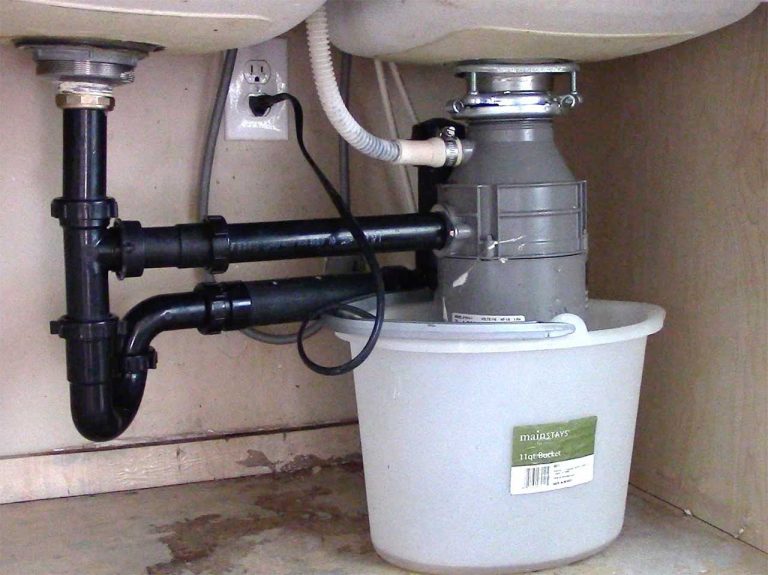Look, Identify, and Fix: What to do When You Have a Garbage Disposal Leak
The garbage disposal is a luxury we may at times take for granted. No need to scrape off that excess food from the plate into the trash. Likewise, no smelly, leftover food scent coming from the trash. Nope, not with the garbage disposal, which magically with the flick of a switch, gobbles all that plate residue up. But, what about when there is an issue? What happens when suddenly you realize you have a Garbage Disposal Leak?
Ok...so, maybe the garbage disposal is not quite the magical, left-over-food-gobbling unit spoke of above. However, it certainly is a handy item to have. Now, back to our question at hand, what happens when you realize you have a Garbage Disposal Leak? Well, you will want to take several angles to look at this issue. First, you will want to look at several points in which the leak could form. Then, we identify where the leak is and decide if this is a "fix it myself" issue, or if we need to call in the pros from Poole's Plumbing.
Where Can I Find My Garbage Disposal Leak?
To start from the beginning, you have found a puddle under your sink that you are not 100 percent sure of where it's coming from. To confirm that this is a Garbage Disposal Leak, there are four spots you want to check in the identifying process.
Listed below, are these four areas that a Garbage Disposal Leak could occur.
- Sink Flange- This connects the bottom of your sink drain to the top part of the garbage disposal
- Dishwasher Connection- normally you'll find this to be a rubber hose that connects to the side of a garbage disposal.
- Drain Pipe- This pipe might be metal, or plastic and its purpose is to drain water and food away and out to the sewer.
- Garbage Disposal- The actual disposal unit itself
Confirming the Source of Your Leak
Keeping in mind that our Garbage Disposal Leak is going to more than likely come from one of the above areas, let's find out for sure. To begin our test and definitively find where the Garbage Disposal Leak is, we first dry the entire outside of the disposal itself. Next, put the stopper in your sink drain and proceed to fill the sink with a few inches of water.
Now, we wait a few minutes, keeping an eye on your disposal, underneath the sink. If there is active dripping occurring, then the Garbage Disposal Leak is coming from the sink flange. However, if there is no drip, we then have to remove the stopper in the sink. Once removed, we then will be able to see water coming from one of the other three areas we discuss above. How we go about fixing the Garbage Disposal Leak, will depend on where we have figured out that the leak is coming from.
Fixing the Garbage Disposal Leak: Can You Do-it-Yourself?
Once the leak is identified, whether or not you can fix it yourself will depend on how skilled you are in plumbing repairs. You will want to proceed here with great caution however, as while it may seem an easy fix, it's easy to get in over one's head on this project.
Below, we will take a look at how you would go about fixing your Garbage Disposal Leak separately in each of the four possible areas it is coming from.
Bolts and Putty for a Leaky Sink Flange
If it is your sink flange that is leaky, this could be a real easy fix. You may only need to tighten all the bolts that hold it on the drain. If that does not stop the leak, the issue could be that you need a new layer of plumbers’ putty to form a new seal.
To do this, loosen all of the mounting bolts, leaving a little space between the flange and drain. Then you can apply a new dab of putty around the drain, re-tighten the bolts, and wait a few hours for the putty to make a tight seal.
Garbage Disposal Leak Coming from Dishwasher Hose or Drain Line: Do I Tighten or Replace?
Now, let's approach the "fix" as if we discovered the leak was stemming from the dishwasher hose. Again, observing is our first step. You have to decipher whether your hose is cracked or just loose.
Now, if it is loose, you can tighten up the hose clamp and our problem is solved. However, in the case of a cracked hose, we will need to replace it with a new one. But once replaced, there should no longer be a Garbage Disposal Leak.
The approach if our leak is coming from the drain line is similar to this. When you analyze, look to see if there is a loose connection. If so, then tighten it up and all should be fixed. However, there is also a seal located inside the connection that could be the problem. In the case that the seal has gotten old and no longer is working, you can replace it and your Garbage Disposal Leak should be a thing of the past.
A Cracked Garbage Disposal= Not Much of a Choice
In the case that we discover the garbage disposal unit itself is cracked, and this is where the leak is coming from, options are limited. Yes, there is a chance that the pros at Poole's could repair that crack. However, in most cases, it would be the most cost-effective if the Garbage Disposal Leak is from and actual crack in the unit to simply replace the entire disposal.
These suggestions once again are based on the fact that you have the confidence in your own plumbing skills to make these minor repairs. If you are at all uncertain, these small issues could turn into a huge mess. So, if you aren't sure of identifying or fixing your Garbage Disposal Leak, contact us and we can help. To contact Raleigh's number one trusted plumbers, Poole's Plumbing, visit poolesplumbing.com.






